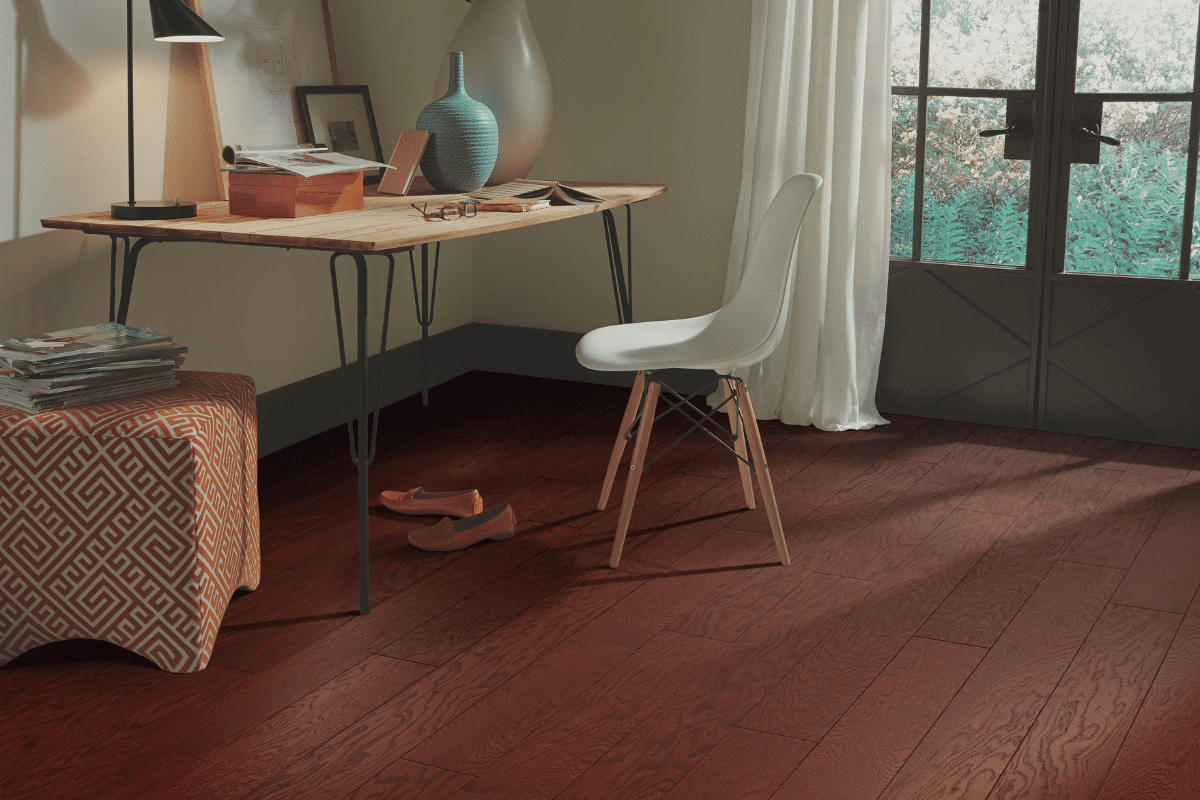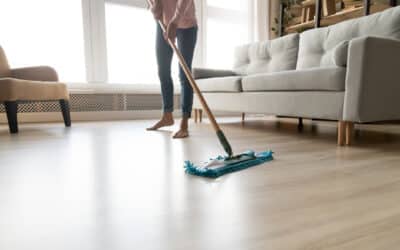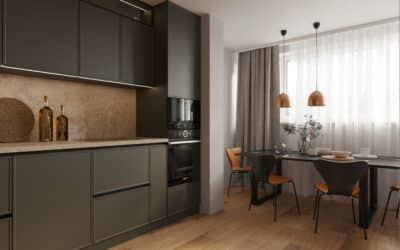Finding the right hardwood flooring starts with understanding your style, budget, and performance needs.
Whether you’re drawn to the warmth of oak, the bold character of hickory, or the sleek elegance of maple, each wood species offers something unique.
In this guide, you will get a clear breakdown of the most popular hardwood types, how they compare in durability, appearance, and price, and what to consider before making your decision. By the end, you’ll be ready to start exploring brands and products with confidence.
What to Consider First When Selecting Your Hardwood Flooring
When you’re just beginning your hardwood flooring search, there’s three main things you will want to consider first:
- Types of Hardwood Flooring
- Popular Wood Species, Colors, Grain Patterns, & Grades
- Prefinished vs Unfinished
Type, species, and finish will factor in as you examine your current décor, determine your budget, and decide on the best flooring for your home or business.
1. Types of Hardwood Flooring
There are two main types of hardwood flooring: solid and engineered.
Vinyl and laminate are different types of resilient flooring.
Solid Hardwood Vs. Engineered Hardwood Flooring
Solid hardwood is a natural, unique, and timeless flooring option. Each plank of solid wood flooring is made from milled wood and is distinct in appearance from one plank to the next.
The appearance of the wood depends both on the tree and how it’s lumbered. The way the lumber is milled determines the amount of sapwood and heartwood in each plank. This, in turn, gives the wood its unique colors, grain patterns and textures, which influences how it accepts hardwood floor stains and finish.
Engineered hardwood flooring is constructed from multiple layers of wood or other materials, with a veneer of real hardwood on top. The construction depends on the manufacturer, the process, and the materials used. For example, waterproof hardwood flooring planks are made with a waterproof core. Read the waterproof hardwood flooring guide here.
Solid hardwood flooring is often more expensive, but it’s also very durable.
Installing hardwood insulates your space and strengthens the overall integrity of your entire flooring structure. You can also refinish solid hardwood multiple times, which is like getting a brand new floor.
Usually, you can refinish engineered hardwood, but it depends on the thickness of the veneer.
Engineered wood flooring is more dimensionally stable than solid wood. This means that planks won’t shrink or swell as much as solid hardwood will in response to humidity levels and changes in temperature.
You will want to if you have a particularly damp or humid environment in your home.
Another advantage of engineered hardwood is that you can install it on, above, or below grade. This means you can install hardwood flooring upstairs and in the basement without issues.
2. Popular Wood Species
The species of hardwood you choose has defining features that almost always comes down to budget and individual preference. One type of wood is not necessarily better than another, and each species is distinctly beautiful.
As you’re talking to flooring professionals, feeling out different products, and reading articles, you’ll notice there’s a range of different wood species available. Each species has different characteristics, colors, patterns, and Janka rating.
Flooring is assigned a grade to denote its quality and characteristics.
Grade names can vary based on the species and manufacturer.
Here we look at the most commonly available hardwoods used in both solid and engineered hardwood flooring.
White Oak Flooring
White oak hardwood flooring is popular for its beauty and durability.
The wood features a tight, straight grain and high density, so it naturally resists warping, cracking, and moisture. This is the reason builders use white oak for everything from flooring to shipbuilding.
White oak has a clean, uniform appearance with a subtle, elegant grain.
It doesn’t have the reddish undertones found in red oak, so it’s perfect for cool or neutral stain palettes, such as natural, gray, whitewash, or modern dark tones.
It’s naturally water-resistant due to its high tannin content, and very stable over time. White oak works beautifully in both traditional and contemporary spaces.
Designers appreciate its soft, understated vibe.
All in all, white oak flooring has everything you could want in a high-quality hardwood floor.
Shop white oak flooring.
Unfinished White Oak Hardwood Flooring
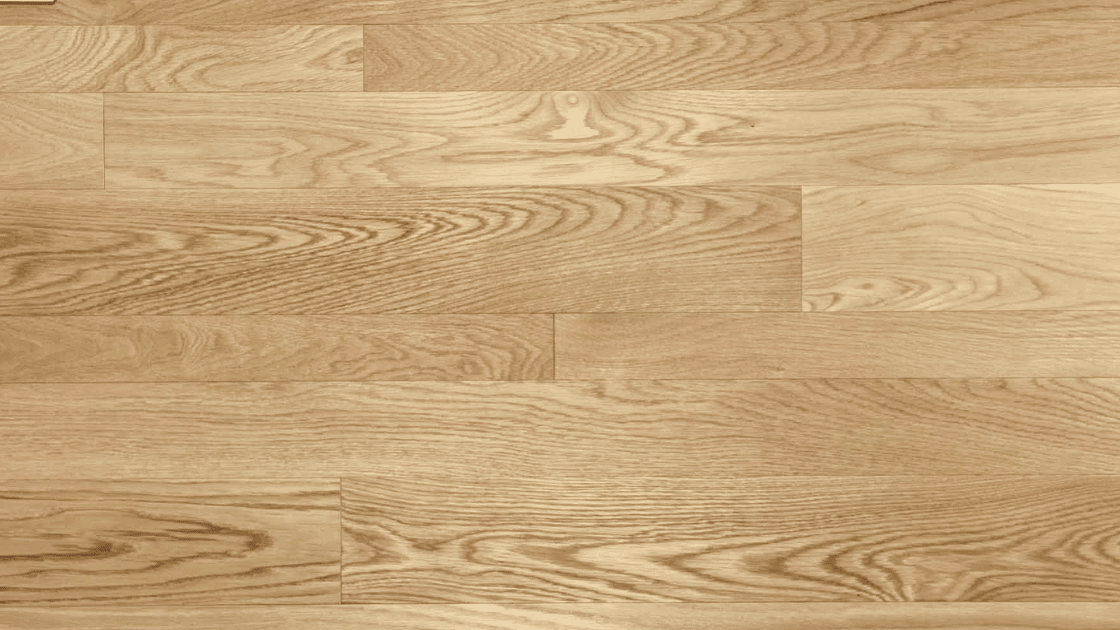
- Janka Rating: 1360
- Colors: Lovely tan and pale brown with pinkish, gray, and brown hues
- Grain Pattern: Close and straight grain with occasional swirls and burls
Red Oak Flooring
Red oak is a classic American hardwood known for its warm undertones, bold grain pattern, and durability.
With a Janka rating of 1290, it’s strong enough to handle everyday wear while offering timeless style.
Red oak features a distinctive, flowing grain and a slightly reddish hue that gives any room a welcoming, lived-in look.
Because it can take stain evenly, you can choose from nearly endless color pathways for a rich, rustic finish or a sleek modern vibe.
If you’re looking for a reliable, stylish hardwood floor with personality, red oak is a solid bet.
Browse our red oak flooring options to find the perfect match for your space.
Unfinished Red Oak Hardwood Flooring
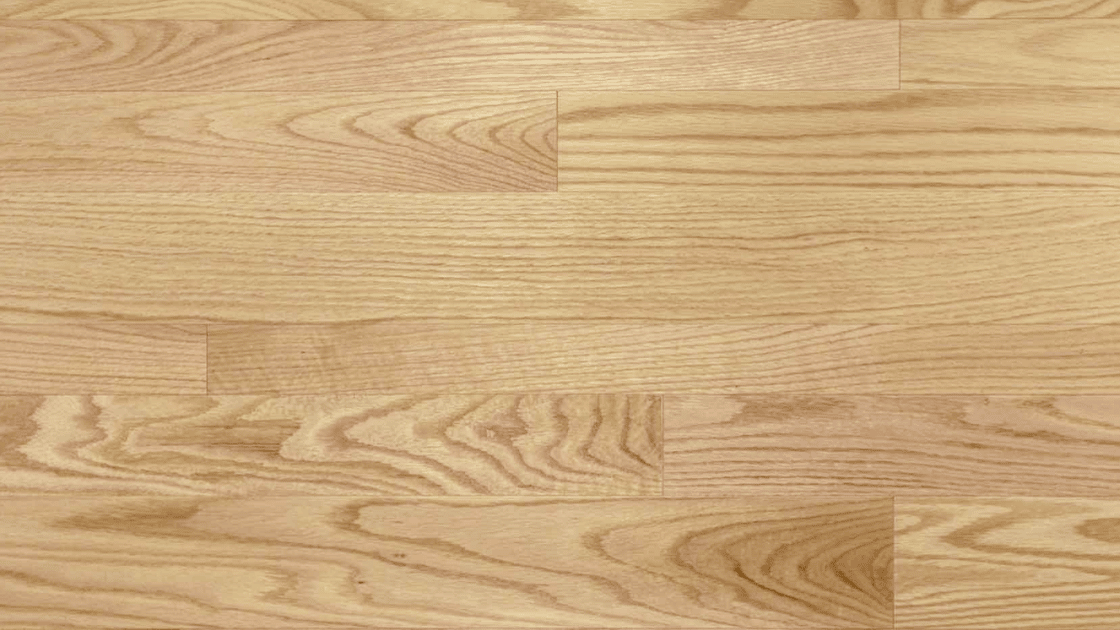
- Janka Rating: 1290
- Colors: Reddish hue with a neutral reddish brown tone
- Grain Pattern: Similar to white oak but more intricate
Ash Flooring
Ash hardwood flooring is an excellent choice for your space because it provides durability and aesthetic appeal.
Looking for hardwood that brings both resilience and a refined, organic beauty to your space? Ash wood may be exactly what you’re looking for.
Its quick growth makes ash a sustainable choice. And its low-maintenance nature fits effortlessly into the rhythms of a busy schedule. But what really sets it apart is the energetic, sometimes wavy grain that masks wear while adding dynamic texture underfoot.
Ash ranges in tone from pale straw to rich dark brown to give you a spectrum of design possibilities. And thanks to its Janka hardness of 1320, it’s tough enough to take on everyday wear with ease.
Unfinished Ash Hardwood Flooring

- Janka Rating: 1320
- Colors: Pale straw to dark brown
- Grain Pattern: Bold and occasionally wavy
Hickory Flooring
Hickory is a strong and dense wood with a Janka rating of 1820, making it very resilient.
Hickory has a non-uniform grain pattern that’s full of character.
It comes in a wide range of colors from medium tan and light reddish-brown to warm grey-brown and deep chocolate.
If you’re looking for something with a look similar to cherry but more rugged, hickory is what you want.
It’s a popular choice for its durability and rustic charm, but keep in mind that hickory is known to expand and contract with changes in temperature and humidity. Proper acclimation is key.
Once installed, though, it’s tough to beat. Hickory is highly scratch resistant, easy to maintain, and adds a distinct, natural beauty to any room.
Shop hickory flooring in a variety of widths and finishes.
Unfinished Hickory Hardwood Flooring

- Janka Rating: 1820
- Colors: Medium tan and light brown red to warm-grey brown and dark chocolate
- Grain Pattern: Non-uniform
Hard Maple Flooring
Like Hickory, hard maple is one of the strongest, most durable types of wood flooring available.
With a Janka hardness of 1450, hard maple is built to handle serious foot traffic.
It’s a smart pick for busy households, commercial spaces, and anyone who needs a floor that won’t flinch under pressure.
Visually, maple is clean and understated. It has a fine, uniform texture, a straight grain, and just enough character curls to keep it interesting.
Maple brings quiet confidence into your space. Nothing flashy. Just solid beauty that holds up.
Color-wise, maple ranges from warm tan and light brown to deeper reddish-brown hues. It takes stain well, though its dense grain can produce a more subtle look compared to oak or ash.
If you’re after something that’s strong, stable, and built to last, maple’s worth considering.
Shop hard maple hardwood flooring in a range of widths and finishes.
Unfinished Maple Hardwood Flooring
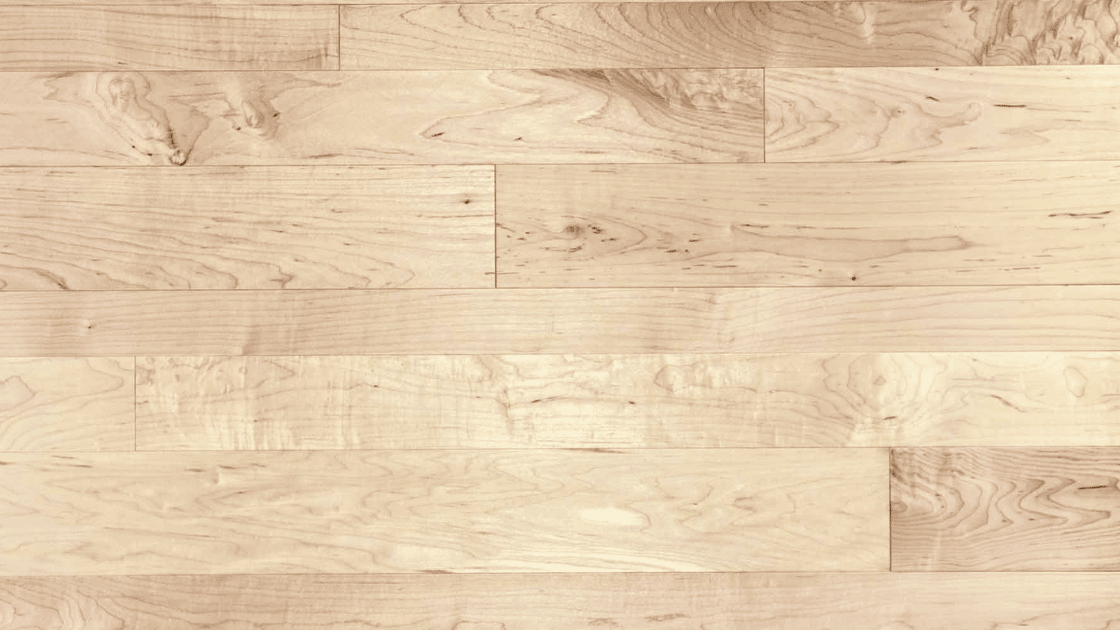
- Janka Rating: 1450
- Colors: Light brown and tan shades or dark reddish brown hues
- Grain Pattern: Straight grain with occasional curls
Cherry flooring has a fine, straight grain that’s sometimes gently wavy.
And many people adore it for its elegant, silky appearance.
The color palette ranges from light pinkish tones to deep, rich red-browns for a warm, inviting feel.
With a Janka rating around 950, American cherry is softer than species like oak or maple, so it will dent and wear more easily in high-traffic areas.
But for many, that natural aging from wear adds to its charm.
What really sets cherry apart is how it matures over time. As it’s exposed to light and air, the wood darkens and deepens in color, developing a rich patina that adds depth and character.
It’s a dynamic, evolving floor that looks better over time.
Unfinished Cherry Hardwood Flooring

- Janka Rating: 950
- Colors: Light pinkish and pale to dark red-brown hues
- Grain Pattern: Fine, straight grain that can be wavy
Walnut Flooring
Whether you’re looking to revamp your dining room or update the entryway in your living room, walnut flooring is a beautiful option.
Walnut flooring brings a rich, sophisticated look to any space.
With a Janka rating of 1010, it’s softer than other hardwoods. But what it may lack in hardness, it more than makes up for in beauty.
It features a straight, open grain with flowing patterns and subtle purple or gray undertones, all wrapped in a deep, chocolate-brown base.
Walnut’s contrast and warmth makes it one of the most visually striking hardwoods available.
Walnut floors shine in bright, airy spaces where sunlight enhances the depth and complexity of the wood’s color.
If you’re looking to create a sense of luxury and timeless style, walnut is a standout choice.
Unfinished Walnut Hardwood Flooring

- Janka Rating: 1010
- Colors: Rich, dark brown color, and swirling purple accented hues
- Grain Pattern: Straight open grain
Heart Pine Flooring
Although pine is a softwood, heart pinewood flooring is incredibly durable with a Janka rating of 1225.

Heart pine has a distinct, rustic grain that’s full of character. Expect to see pinholes, knots, and rich natural variation. It’s perfect for farmhouse, vintage, or country-style interiors.
The color palette ranges from golden yellows to deep, reddish browns, and some boards even feature natural sap stains that add a unique, aged look you won’t get from other species.
With its texture and warm tones, heart pine brings a sense of history into your space.
Whether you’re restoring an old home or building something new with a classic touch, it’s a wood that hearkens into the past.
Unfinished Pine Hardwood Flooring

- Janka Rating: 1225
- Colors: Rich yellow to dark brown color tones
- Grain Pattern: Beautiful, distinct grain pattern that features pinholes and knots
What About Bamboo Flooring?
Bamboo is not a type of hardwood – it’s a woody grass that can be every bit as durable as solid wood. With a Janka rating that ranges from 1300–1400, Bamboo flooring can be a good option unless you live in an area with fluctuating temperature and humidity.
Hardwood Flooring Grades
Listed in order are the different flooring grades.
Clear: The cleanest of the clean, clear grade hardwood is picked through and close to perfect.
Select: Select grade hardwood is very clear with some small knots that are the size of a dime.
#1 Common: #1 common grade hardwood has a little mineral streaking and knots no larger than the size of a quarter.
Builder: Builder grade hardwood is a combination of #1 common and #2 common.
#2 Common: #2 common grade hardwood doesn’t meet the requirements for select or #1 common and are typically shorter in length.
Character: Character grade hardwood includes everything from the tree.
Price Per Sq. Ft.
The prices for hardwood flooring are often changing, depending on the availability of wood and many other factors. For any hardwoods not listed in this guide, you can contact us for a quote. We can help you find what you’re looking for.
3. Prefinished Vs Unfinished Wood Flooring
When it comes to solid or engineered hardwood flooring, you have the option of purchasing prefinished or unfinished wood.
Prefinished wood flooring comes with the finish already applied, so it’s ready to install as soon as it’s delivered.
Unfinished wood flooring requires someone to install, sand, and finish the floor.
This gives you more control over the final look, but it requires more thought and time. It also requires professional skills. If you choose unfinished hardwood, you will have to hire an experienced contractor.
Installation, sanding, and finish play a significant part in the final appearance and performance of your floor.
An experienced and skilled contractor who knows what they’re doing makes all the difference.
An experienced contractor will make sure the sub flooring is level. If the flooring surface isn’t perfectly level before you install it, then you will have noticeable problems after your flooring installation.
If you go with unfinished wood, there’s different types of finishes that can be applied to hardwood floors, and each one will affect the overall look and feel of the floor.
Some types of finishes include oil and water-based polyurethane, and natural hard-wax oils. Before choosing a finish, you may find it helpful to consider the different sheens available.
Summary
So, what’s the right hardwood flooring for your home? It depends on your needs, style, and budget. With so many options available, it can be tough to decide which type of wood flooring is right for you. That’s why it helps to first explore, then weigh the pros and cons of each option before making your choice.
Hardwood flooring is a great investment that will add value to your home and last for years. Finding the perfect flooring for your unique space is a challenge. It’s also a long-term decision. But the more you know, the more likely you’ll soon be experiencing the hardwood floor of your dreams.
Find the Perfect Hardwood Floor
Browse over 1,000 different hardwood floors from the best brands across the industry.
Shop by type, color, species, color, width, collection, brand, and more.
Have specific questions about flooring or looking for a more custom approach? Give us a call or send us a message. Our NWFA-certified flooring pros will help you!






